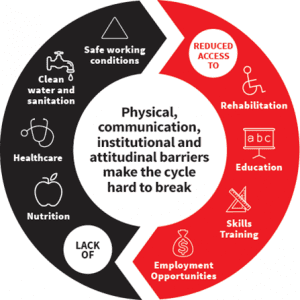Disability is both a cause and consequence of poverty.
It is a cause because it can lead to job loss and reduced earnings, barriers to education and skills development, significant additional expenses, and many other challenges that can lead to economic hardship.
It is also a consequence because poverty can limit access to health care and preventive services, and increase the likelihood that a person lives and works in an environment that may adversely affect health.
The result? Poverty and disability go hand in hand. The poverty rate for working-age people with disabilities is nearly two and a half times higher than that for people without disabilities. Indeed, recent research finds that half of all working age adults who experience at least one year of poverty have a disability, and nearly two-thirds of those experiencing longer-term poverty have a disability. People with disabilities are also much more likely to experience material hardships such as food insecurity; inability to pay rent, mortgage, and utilities; or not being able to get needed medical care than people without disabilities at the same income levels. The same goes for families caring for a child with a disability.
In addition to income poverty, individuals with disabilities are also nearly twice as likely to lack even modest precautionary savings in case of an unexpected expense or other financial shock. Fully 70 percent of individuals with disabilities responded that they “certainly” or “probably” could not come up with $100 to meet an unexpected expense, compared to 37 percent of individuals without disabilities.

10 Facts About Disability and Poverty
1. Disability is an umbrella term that covers both the physical and mental conditions that limit a specific person’s senses, activities, movements or ability. According to the World Health Organization (WHO), disability is a human rights issue and is a very complex phenomenon.
2. Disability is both a cause and consequence of poverty. This means that people who experience poverty are more likely to become disabled and people with disabilities are more likely to live in impoverished conditions.
3. It is no surprise that the cost of living for a person with disability is higher than for an average person. people with disabilities in poverty face economic problems due to things like additional medical treatment, rehabilitation and education access. WHO states that people with disabilities are 50 percent more likely to suffer from disruptive health expenditures.
4. Almost half of the persons with disabilities population cannot afford healthcare. It is common that disability is preventable or treatable, but often times people with disabilities in poverty will go their entire lives without proper healthcare. Without treatment, medical conditions can worsen.
5. In additional to overpriced healthcare, there is a lack of qualified healthcare professionals in developing countries. Also, people with disabilities are much more vulnerable to deficiencies in the healthcare system.
6. Assistant devices or rehabilitation allow people with disabilities to be independent. However, disabled people in poverty typically lack access to these medical devices and health treatment. The WHO states that “access to rehabilitation can decrease the consequences of disease or injury, improve health and quality of life and reduce the use of health services.
7. People with disabilities are likely to have very limited education opportunities. For example, a deaf child is likely to be denied access to education because the school does not offer sign language-friendly tuition. This lack of education permanently affects the socioeconomic status of people with disabilities in poverty.
8. For people with disabilities in poverty, securing work is extremely difficult. This can be due to the lack of accessibility in the workplace or discrimination. Only 45 countries have anti-discrimination laws to protect people with disabilities. As a result, treating disability can be very difficult for people with disabilities in poverty because disabled people have a hard time finding a stable job.
9. People with disabilities in poverty often times are put at risk due to impoverished living conditions. Recent research shows that there are alarming health condition trends associated with disability. UNICEF states that disabled people are more likely to contract infectious diseases and injuries. According to the WHO, many people with disabilities experience premature death.
10. UNICEF states that it is important that people with disabilities in poverty gain affordable access to treatment. For some developing countries, global and nonprofit intervention is necessary. According to the World Bank, disability-inclusive development is being made. For example, the United Nations Convention on the Rights of Persons with Disabilities will help countries establish disability discrimination laws and create disability-friendly policies.


No comments:
Post a Comment